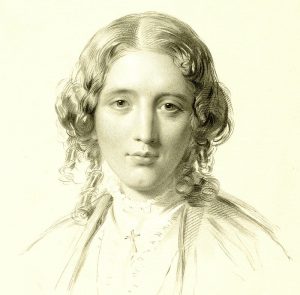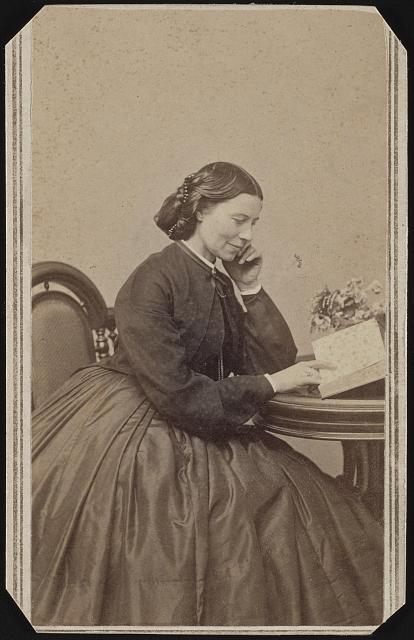Women’s Voices Echoing Nationally during the American Civil War
March 8 is International Women’s Day, and this week I’ve been thinking of the ways that women impacted Civil War history and how the war changed them both individually and through societal shifts. There is plenty to consider and reconsider on the subject. I usually think of women’s history in more of the local or microhistory level with influence sometimes stretching into the macro levels. The Civil War era was still a time that it was unlikely to find women in large leadership roles, although the war also provided the catalyst for some of that change in America.
However, women’s voices did find their way into the national scene, oftentimes through the arts where they could exert powerful influence and still maintain traditional roles. For the purpose of this article, I’ve tried to think of a moment (or a movement) from each year of the Civil War where a woman’s voice or something that happened to a woman made national news in a way that shaped our understanding of the era. This is not meant to be a comprehensive article on the subject, and there are other examples that arguably could have made the list. Also, I admit that the choices may seem unbalanced with more Union-supporting women making the list; this stems from the different social roles for women in the north versus the south and not from intentional exclusion.
In 1861 Julia Ward Howe penned the words to the Battle Hymn of the Republic, a song forever associated with the Union cause and the Civil War. The tune had existed since the mid-1850s, probably originating through camp meeting revivals, and various groups wrote lyrics to suit their religious or later political views. Julia Howe heard Union soldiers singing the version “John Brown’s Body” as they marched. A committed abolitionist, Howe recognized the meaning of the echoing words about the martyr of the abolition cause who had attempted violent means of securing freedom for the enslaved and had been tried and executed for his efforts. Brown had promised that “the crimes [of slavery] of this guilty land will never be purged away, but with Blood” and by 1861, his words looked like a prophecy that was being fulfilled. Drawing on her anti-slavery views and religious beliefs, Julia Ward Howe penned poetry on November 18, 1861 that has become known as the Battle Hymn of the Republic. Her writing was published in February 1862 and became a favorite during and after the war for those who recognized the opportunity for freedom that could come through the years of fighting.

Though her most famous work had been published 10 years earlier, Harriet Beecher Stowe met President Lincoln in 1862. The president reportedly greeted her, saying she was “the little woman who wrote the book that started this great war.” The book he referenced was Uncle Tom’s Cabin, a work of fiction based on fact that made American citizens look at slavery and realize its awful realities. The book became the nation’s second best-seller, falling just behind the Bible in volume sales. Stowe’s book inspired strong reactions, building the ranks of abolitionists, fueling sectional mentalities, and feeding the southern view that their “way of life” was threatened. Whether or not Lincoln actually said the phrase about the book and the war, the connection between Stowe’s writing and the war is clear and recognizable, and by 1862, the president wrestled with the decision to make emancipation an official war aim, shifting from just the restoration of the Union to the additional cause of ending slavery through military means and eventually legislation.
Sometimes it was not a woman’s words that shocked or changed people. Sometimes it was what happened to women…or in 1863 to girls. The brief reporting about the explosion at Brown Island’s ammunition factory in Richmond, Virginia in March 1863 circulated through southern papers and eventually northern papers carried versions of the tragedy, too. It had occurred on March 13, 1863 when friction primer sparked in one of the wooden buildings of the ammunition factory, creating an explosion that instantly killed 10 girls instantly and mortally injured 40 other civilians, mostly females. The factory employed nearly 600 women and girls, mostly of German or Irish immigrant families who worked in close quarters assembling small arms ammunition at the rate of 200,000 cartridges per day. The tragic explosion brought an outpouring of aid to the injured victims and grieving families. The news traveled fairly rapidly through newspapers and one after the incident the New York Daily Herald carried a report. The dangers to women working in ammunition factories made national news, a reminder both of the changing acceptable roles for women and the price paid for unregulated, low wage work.
By 1864 women in both Union and Confederate states placed advertisements in local and national papers to raise awareness and funds for their relief societies. Their names were not always visible, but the evidence of their organizing and efforts spread to a national audience fort their separate sides in the war. The formation of the local, state, or national relief societies sprang from traditional female roles in antebellum society, but also pushed the “acceptable” social boundaries in both the north and the south. In the south, it allowed women to formally organize around a social cause. In the north where many women had already had a more active role in social causes, it allowed them to move a little closer to the public spotlight and genuine recognition for their efforts outside the home. Either way, the publishing of relief society news, asks, and success reports put women’s efforts in the news as they significantly impacted the war effort from the homefront.

Clara Barton stepped forward in 1865 to investigate the fates of missing soldiers. In March, President Lincoln approved her proposal to official work on finding and identifying soldiers who might be dead, wounded, prisoners, or unable to account for themselves. For the next three years, Barton would operate an office in Washington D.C., receiving more than 60,000 requests from the families and friends of the missing soldiers. A quick search of “Miss Clara Barton” through a newspaper archive from 1865 reveals her name identified 150 times across a majority of states, and “Miss Barton” appears another 207 times; many of the references in the newspapers announce her appointment and creation of the Missing Soldiers Office, her work in Andersonville, Georgia, or her office address for families to send inquiries. Barton’s work is a reminder that the war’s effects did not end when the surrenders happened or the fighting ceased. The pain of war and the uncertainty of a loved one’s fate lingered. Barton helped to provide reunions or closure of uncertainty and the beginning of grieving process for many families who were burdened by the harshly vague word “missing” on the casualty lists. Her work was nationally known and part of the slow healing process as the nation struggled to reunite and move beyond the battlefields.
These are a few, limited examples of moments when a woman’s words or influence were nationally recognized and became part of our understanding of the Civil War serve. It is a reminder that through poetry, literature, war work, relief societies, and humanitarian work women of the Civil War era did exert a national influence at certain times and their names, their stories, or their causes gained recognition as publishers or newspapers gave voice to their ideas through the power of print.
Great post highlighting well deserving women.
Thanks for this wonderful overview, Sarah!